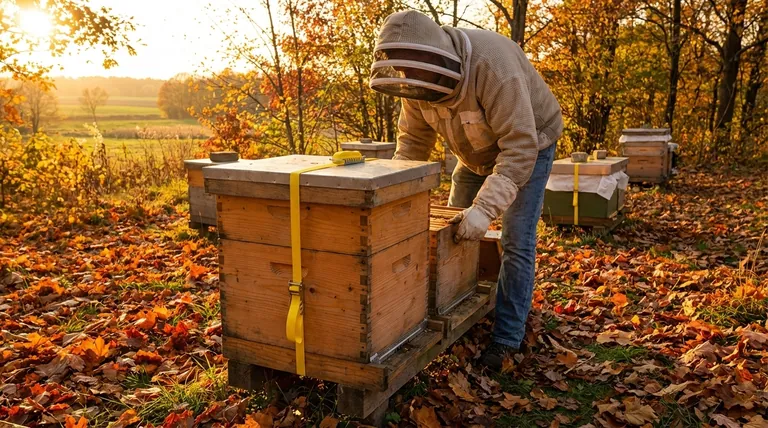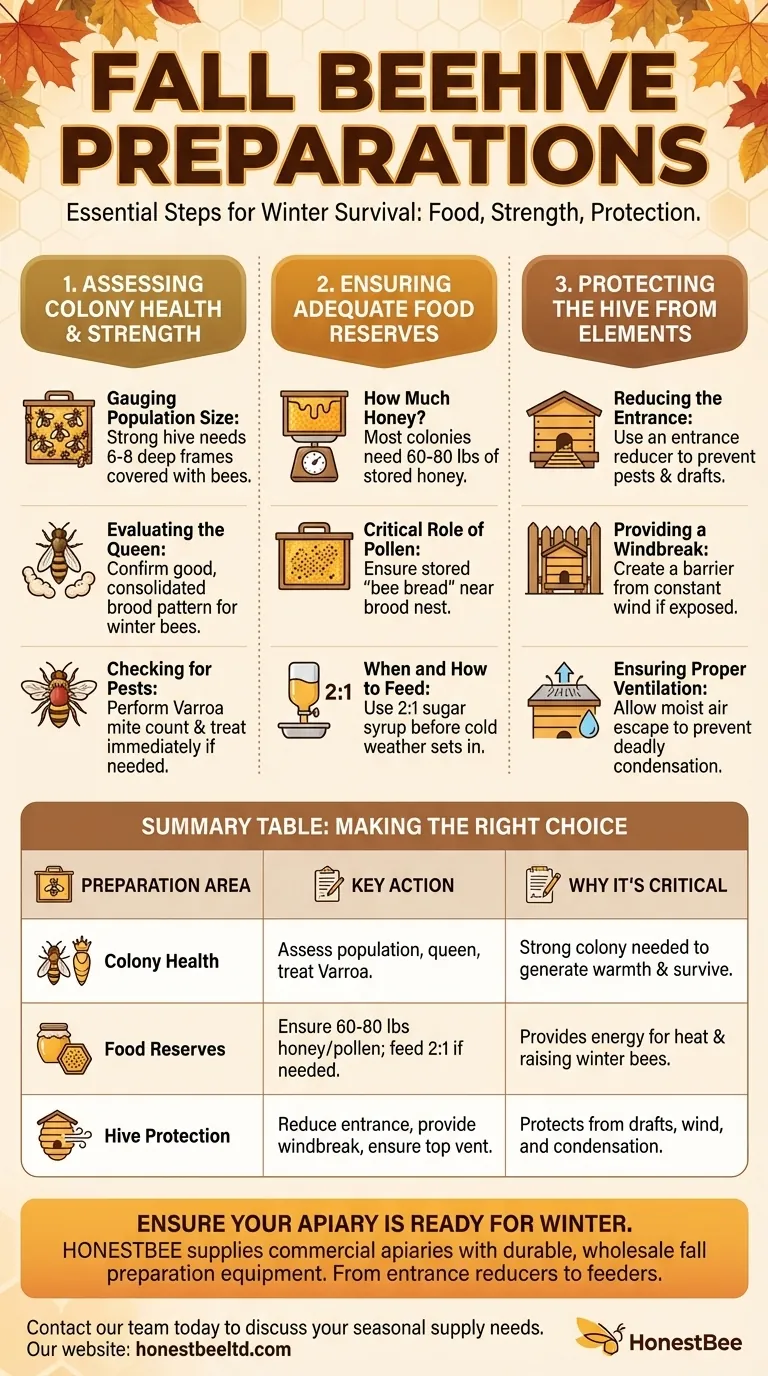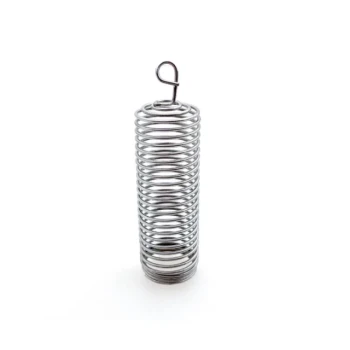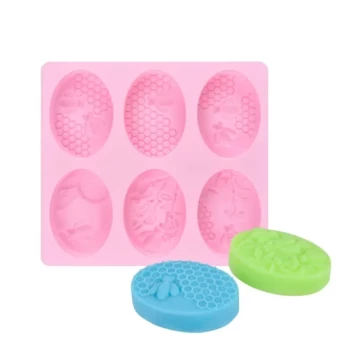The essential preparations for a beehive in fall center on three critical goals: ensuring the colony has ample food stores to last until spring, confirming the colony is strong and healthy enough to generate warmth, and protecting the physical hive from the harsh winter elements. Your role is to assess these areas and intervene only when necessary to help the bees succeed.
The core principle of fall beekeeping is not to manage the bees, but to set the stage for their survival. Your actions in autumn directly determine whether the colony has the population, food, and protection required to endure the cold months ahead.

Assessing Colony Health and Strength
Before you can prepare the hive, you must first understand its current state. A weak or diseased colony has very little chance of surviving winter, regardless of how much food it has.
Gauging Population Size
A large population of bees is the colony's engine. They are needed to form a tight cluster that generates heat throughout the winter.
A strong hive entering fall should have bees covering at least six to eight deep frames. A smaller population will struggle to maintain the necessary temperature inside the cluster.
Evaluating the Queen
The queen's performance in late summer and early fall is critical. She lays the eggs that will become the "winter bees"—physiologically different bees that are built to live for months, not weeks.
Confirm you see a good, consolidated brood pattern. A spotty or absent brood pattern in early fall is a major red flag that the queen may be failing.
Checking for Pests and Disease
Winter is a period of stress, and pests can easily overwhelm a confined colony. Varroa mites are the single greatest threat to overwintering bees.
Perform a mite count in late summer or early fall. If the numbers are above the recommended threshold for your region, you must treat the colony immediately. Waiting too long allows mites to weaken the crucial generation of winter bees.
Ensuring Adequate Food Reserves
Honey is the carbohydrate bees use for energy to shiver and produce heat. Without enough honey, the colony will starve, even if it is large and healthy.
How Much Honey is Enough?
The amount of food a colony needs depends on your climate's severity and the length of your winter.
A standard deep hive box full of honey weighs approximately 80-90 pounds. Most colonies in cold climates need at least 60-80 pounds of stored honey to reliably survive winter.
The Critical Role of Pollen
Pollen is the colony's source of protein and fat. It is essential for raising the final rounds of winter bees.
Ensure the bees have several frames with stored pollen (often called "bee bread") located near the brood nest. This will be the first food source for the queen to ramp up egg-laying in late winter.
When and How to Feed
If you inspect the hive and find it is light on honey stores, you must begin supplemental feeding immediately.
Feed a heavy sugar syrup at a 2:1 ratio (two parts sugar to one part water). This thick syrup mimics honey and is easier for the bees to store without having to dehydrate it extensively. Stop feeding once cold weather sets in (consistently below 50°F / 10°C), as they will be unable to process it.
Protecting the Hive from the Elements
While bees can manage the cold, they are highly vulnerable to wind and moisture. Your goal is to create a dry, draft-free home.
Reducing the Entrance
A large, open entrance is a major source of heat loss and a security risk. In the fall, mice and other pests will look for a warm place to nest.
Use an entrance reducer to shrink the hive opening to its smallest size. This helps the bees defend their home and reduces cold drafts.
Providing a Windbreak
Constant wind will strip heat from the hive and force the bees to consume their honey stores at a much faster rate.
If the hive is in an exposed location, create a windbreak using bales of hay, a small fence, or a tarp secured to stakes. Ensure there is still adequate airflow to prevent moisture buildup.
Ensuring Proper Ventilation
Moisture, not cold, is the silent killer of winter colonies. As the bees cluster and respire, they release warm, moist air. If this air hits a cold inner cover, it will condense, and cold water will drip down onto the bees.
Create a small upper entrance or prop the inner cover up slightly to allow this moist air to escape. Proper ventilation is absolutely essential for a dry, healthy winter cluster.
Making the Right Choice for Your Colony
Your specific actions will depend on your climate and the condition of your bees. Assess your hive's status first, then take decisive action.
- If you are a new beekeeper: Focus on the two most critical factors: ensure the hive is heavy with food and perform a Varroa mite treatment.
- If you are in a very cold climate: Prioritize creating a windbreak and ensuring the hive has proper top ventilation to prevent condensation.
- If you are in a milder climate: Your bees may need less honey, but pest pressures can remain high, so continue to monitor for mites and hive beetles.
Ultimately, your fall preparations are the most important work you will do as a beekeeper all year.
Summary Table:
| Preparation Area | Key Action | Why It's Critical |
|---|---|---|
| Colony Health | Assess population, queen, and treat for Varroa mites. | A strong, healthy colony is needed to generate warmth and survive. |
| Food Reserves | Ensure 60-80 lbs of honey and pollen stores; feed 2:1 sugar syrup if needed. | Provides energy for heat and nutrition for raising winter bees. |
| Hive Protection | Reduce entrance, provide a windbreak, and ensure top ventilation. | Protects from cold drafts, wind, and deadly condensation/moisture. |
Ensure Your Apiary is Ready for Winter
A successful overwintering season starts with the right equipment and supplies. HONESTBEE supplies commercial apiaries and beekeeping equipment distributors with the durable, wholesale-focused supplies needed for effective fall preparations.
From entrance reducers and mite treatments to reliable feeders, we provide the tools that support strong, healthy colonies. Let us help you set the stage for your bees' survival.
Contact our team today to discuss your seasonal supply needs.
Visual Guide

Related Products
- Professional Galvanized Hive Strap with Secure Locking Buckle for Beekeeping
- Heavy-Duty Nylon Beehive Hive Strap with Stainless Steel Cinch Buckle
- Versatile Ratchet Hive Strap with S-Hooks for Secure Fastening
- Langstroth Honey Bee Box Hive Boxes for Different Depths
- Jenter Queen Rearing Kit Complete Set for Bee Breeding
People Also Ask
- What is the advantage of using cam buckle straps? Secure Your Load Fast with Simple, Safe Tensioning
- What are the types of Emlocks available? Choose the Right Strap for Hive Security
- Can straps with hook ends be used for beehives? A Guide to Secure Hive Management
- What are the two styles of hive straps? Choose the Right Strap for Your Hive Security
- How can beekeepers secure the top cover of a hive? Protect Your Colony from Wind and Weather



















